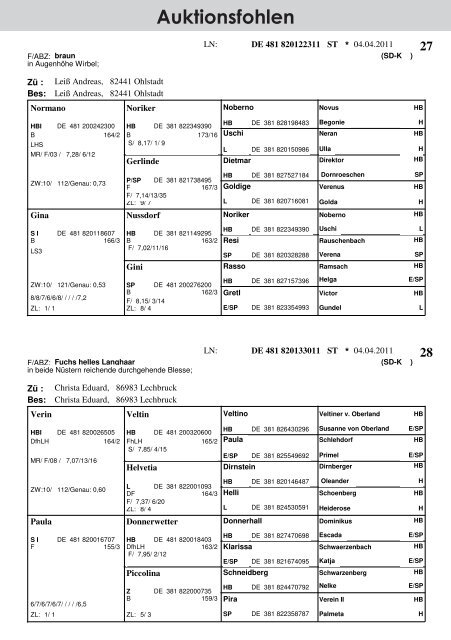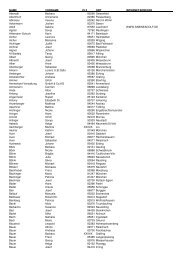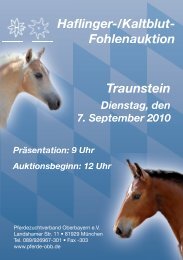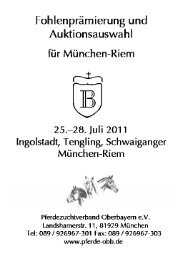Rottenbuch Kaltblut - Pferdezuchtverband Oberbayern eV
Rottenbuch Kaltblut - Pferdezuchtverband Oberbayern eV
Rottenbuch Kaltblut - Pferdezuchtverband Oberbayern eV
Sie wollen auch ein ePaper? Erhöhen Sie die Reichweite Ihrer Titel.
YUMPU macht aus Druck-PDFs automatisch weboptimierte ePaper, die Google liebt.
5. Other aspectswhen implementing SNELThe implementation of EN 81-80 per country, based on the 74defined risks, will vary in content and scheduling, to allow forany local differences in the assessment of those risks.The definition of risks levels, categorized as extreme, high,medium or low, will depend on previous country history of liftregulation and applied standards, accident statistics, specificproduct knowledge and social expectations.In SNEL, annex A, the described methodology of the “NationalFiltering Method” provides a tool for easily and successfullydefining the “when” and “what” status of each predefinedSNEL risk.Today, this filtering process, which has been appliedsuccessfully in several European countries, among themBelgium, France, Spain or Austria, is on-going in other EUmember-states…Using the filter as recommended by the experts who wrote thenorm, will bring a de facto safety harmonization of the existinglifts. It will be a great leap forward for European integration.5.1 Energy consumptionEnergy efficiency is required from all equipment of thebuilding in today’s society. Energy has become paramount inthe fight against global warming and the reduction of CO2emissions. Since the building stock is responsible for roughlyhalf the emissions of CO2 in Europe, through heating anddirect emissions, but also through indirect emissions, whenproducing electricity used by the building equipment, fromheating and cooling to running lifts and escalators.Lifts don’t consume a lot of energy, since electrical lifts andsome models of hydraulic lifts function with a counterweightthat strongly reduces the need for electricity in running thelift up and down in its shaft. ELA has participated to thedevelopment of the E4 Report (Energy Efficient Elevators &Escalators), with the support of the European Commission(Intelligent energy unit), and the measurements made on tensof lifts throughout Europe clearly indicate that despite of its lowconsumption, the lift can still see its electricity consumptiondrastically reduced, mainly by replacing existing incandescentlighting with new types of lamps and by installing controllersthat will provide different sleep modes for the lift and reduceits consumption when the lift is in standby...which is most ofthe time.The E4 group has calculated that the overall energy efficiencycould reduce the electricity demand by 4 Terawatts, if allexisting lifts in Europe were improved for energy efficiency.Lateral thinking makes it that the European Commission andnational deciders are to be convinced by the fact that themodernisation of the lift stock can mean several benefits atthe same time: SAFETY of users through the application ofSNEL, but also ENERGY EFFICIENCY improvements throughthe application of the E4 recommendations and improvedACCESSIBILITY to the disabled, whether temporary orpermanent, as well as senior citizens, who can remain homelonger and not be put into institutions where they don’t feel athome and which represent high costs for society. ImprovingSafety through SNEL is a Win Win objective that can also havean impact on energy efficiency and accessibility for all.12ELA SNEL white paper April 2013






